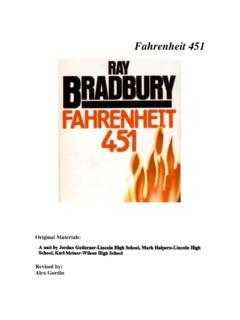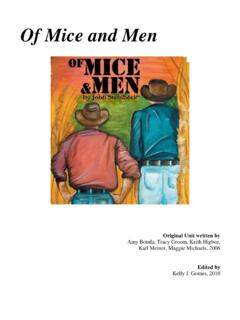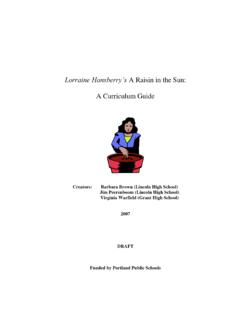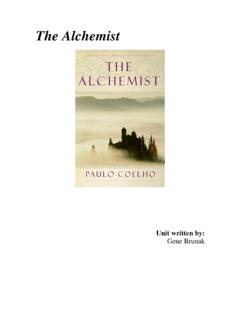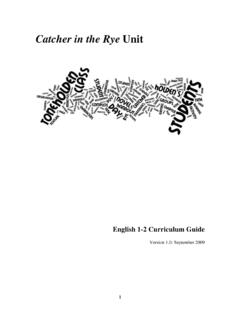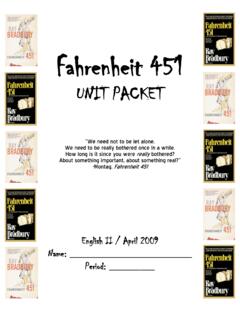Transcription of Fahrenheit 451 - Portland Public Schools
1 Fahrenheit 451 Original Materials: Revised by: Alex Gordin 2 Original Introduction 3 A Combustible Narrative Fahrenheit 451 Curriculum Revision It was a pleasure to burn (3). Thus begins the dustpan story of a futuristic society, Fahrenheit 451 written by Ray Bradbury. This powerful novel and accompanying curriculum have been designed for the 10th grade level. The unit has undergone at least three revisions by Portland Public School Language Arts Teachers. This unit, magnanimous in scope, was selected as one of the core units for the 2010-11 school year and will be available for sophomore teachers of 10th grade classrooms as part of a pilot project. The special focus on the literary unit was articulated through the creative lens of Grant Wiggins and Jay McTighe s, text, Understanding by Design, an innovative set of learning ideas whose main premise, Backwards Design, is illustrated by the template created at the beginning of this unit.
2 Also, in this set of deliverables include a table of contents, lessons of the learning plan labeled with academic priority standards, a pre-assessment, two culminating assessments in student-friendly language, differentiated possibilities, and a list of literary terms that have been used in the unit. Finally, a resources section has been added for additional textual selections that may be helpful for the teacher or student learner. Importantly, the 10th Grade Write Source and the 10th Grade Holt Anthology were extensively referenced to assist the teacher and student in the composition of the two possible assessments. Essential questions that provided the impetus for the curricular unit are as follows: How does the story affect individuals in society? How do people engage in social protest? What is the importance of books? What is a theme learned from the text?
3 The culminating assessment and alternative culminating assessments or final projects are focused on expository writings. The traditional culminating piece is the thematic essay and the alternative assessment is a research project on a theme that connects to today s society. Consistent with the Backwards by Design model, the larger goals are explored, followed by the specific learning practices that allow the student to create and make connections to the text, all, with an organized and punctual format in 4 mind. Strategies are specified to allow the student to reflect on the text and review some of the ideas that have been already presented in the classroom. Pre Assessment strategies introduce the student to the culminating project; the writing process scaffolds and leads to the final writings. Poignantly, there is a differentiated example of the thematic essay that has been included for students having a challenging time.
4 A Revision and Editing handout has been added to aid the student in writing process. Connections have been made to the 10th Grade Write Source to provide easier access to this powerful novel that the Portland Public School System has adopted. Lastly, there is a student reflection designed so that students may review the writing traits and learning process. The study and written investigation of themes of Fahrenheit 451 is not only useful in the classroom but a significant benchmark for thinkers everywhere. 5 Fahrenheit 451 Template Stage 1: Desired Outcomes Priority Standards: (number and description) Reading Analyze figurative expressions, comparisons and analogies Draw conclusions about reasons for actions/beliefs and support assertions. Literature :Students will identify the development of themes. : Describe the function and effect upon a literary work of common literary devices such as symbolism, and irony.
5 : Evaluate how literary elements (conflict, point of view, and setting are used to establish mood, place, time period, and cultures, and contribute to there development of its theme. Writing : Establish a context where appropriate : Writing Conventions such as roots, bases, prefixes, suffixes, correct use of pronouns. : Develop a thesis. Support a position with precise and relevant examples. Optional: Use effective note taking techniques to ensure proper documentation. Understandings: Students will understand The narrative elements of the novel. The identification of literary devices and their effect on the meaning of the story. How to compose a literary essay. Discuss key episodes, events, and ideas and interpret them on a literal, interpretive, and universal level Essential Questions: How does this story affect individuals and society in the 21sst century?)
6 How do people engage in social protest? What is the importance of literacy in society? What is the importance of books? Why read? What is a point or theme learned from the story or narrative? Students will know: the levels of questioning the story and narrative by Ray Bradbury. literary elements and particularly focus on figurative language such as metaphor, simile and symbolism. Students will be able to: compose a thesis and compose a literary essay. apply ideas of the text to higher applications. Stage 2: Assessment Evidence Culminating Assessment (learning task) Other Evidence Students will write a literary analysis essay. Students may create a brochure on a related social justice issue around related topics of banned books, or a controversial literacy topic. 6 Stage 3: Learning Plan Fahrenheit 451 Activity Title Priority Standards This Guide Original Guide Lesson #1: Essential Question -- What if?
7 Draw conclusions about reasons for actions/beliefs and support assertions. :Students will identify the development of themes. 9 9 Lesson #2: A Pleasure to Burn Draw conclusions about reasons for actions/beliefs and support assertions. :Students will identify the development of themes. 11 12 Lesson #3: Using Active Notes Draw conclusions about reasons for actions/beliefs and support assertions. :Students will identify the development of themes. : Describe the function and effect upon a literary work of common literary devices such as symbolism, and irony. : Evaluate how literary elements (conflict, point of view, and setting are used to establish mood, place, time period, and cultures, and contribute to there development of its theme. 13 14 Lesson #4: Pre-assessment Draw conclusions about reasons for actions/beliefs and support assertions. :Students will identify the development of themes.)
8 : Establish a context where appropriate : Writing Conventions such as roots, bases, prefixes, suffixes, correct use of pronouns. : Develop a thesis. Support a position with precise and relevant examples. 16 Lesson #5: Burn all, burn everything Draw conclusions about reasons for actions/beliefs and support assertions. :Students will identify the development of themes. 19 26 Lesson #6: Tiered Lesson Draw conclusions about reasons for actions/beliefs and support assertions. :Students will identify the development of themes. : Describe the function and effect upon a literary work of common literary devices such as symbolism, and irony. : Evaluate how literary elements (conflict, point of view, and setting are used to establish 23 7 Activity Title Priority Standards This Guide Original Guide mood, place, time period, and cultures, and contribute to there development of its theme.)
9 : Develop a thesis. Lesson #7: Motifs : Describe the function and effect upon a literary work of common literary devices such as symbolism, and irony. : Evaluate how literary elements (conflict, point of view, and setting are used to establish mood, place, time period, and cultures, and contribute to there development of its theme. 34 52 Culminating Assessment : Identify the development of theme : Use organizational structures such as introduction, body, and conclusion : Provide transitions to link paragraphs. : Develop a thesis : Support a position with relevant examples 36 Lesson #8: Introduction : Develop organizational structures such as introduction, body, and conclusion 39 Lesson #9: Body : Develop organizational structures such as introduction, body, and conclusion 40 Lesson #10: Conclusion : Develop organizational structures such as introduction, body, and conclusion 41 Alternative Culminating Assessment :Develop a thesis : Support ideas with precise examples and documentation : Develop ideas into paragraphs : Include transitions : Conventions 42 Lesson #11: Outline, note card, information gathering : Support ideas with precise examples Use effective note taking techniques to ensure proper documentation.)
10 45 Lesson #14: Unit Reflection 47 Resources 49 8 Academic Vocabulary The vocabulary used extensively in this unit on Fahrenheit 451: Allegory Passage Epigram Allegory Imagery Symbolism Metaphor Simile Motif Theme Archetype Allusion Alliteration Assonance Characterization Blocking Setting Dialogue Protagonist Subtext Personification Metonymy Theme Thesis Connotation Denotation 9 Lesson #1: Essential Questions What if? Overview: This lesson asks students to engage with the idea of speculative literature like this novel. 10 11 Lesson #2: A Pleasure to Burn Overview: this lesson will introduce students to the close reading approach we will be taking through the study of this novel. 12 The Opening of Fahrenheit 451 13 Lesson #3: Using Active Notes Overview: Introduce students to the ways that they will take notes during the study of the novel.
